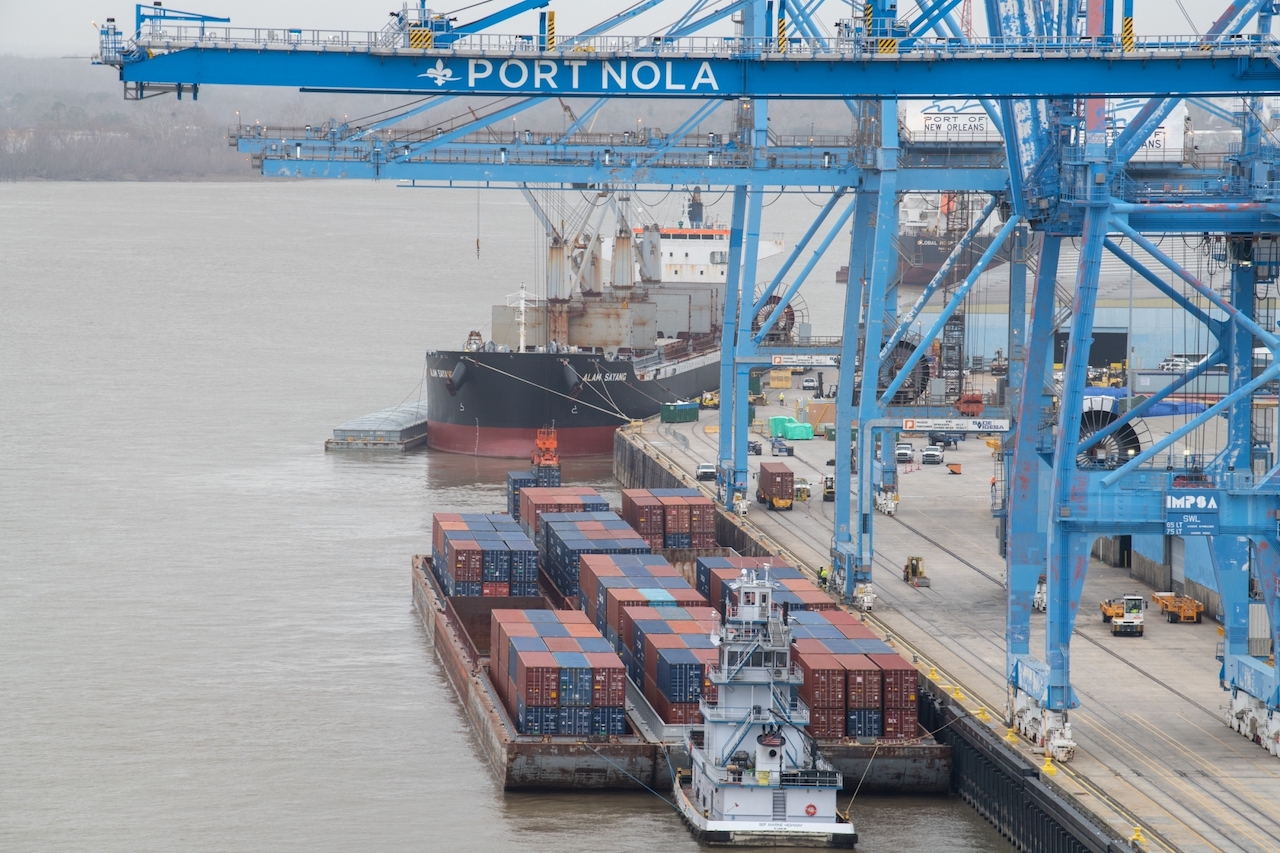
Intermodal Briefs: Port NOLA, Port of Oakland
Written by Carolina Worrell, Senior Editor
(Port NOLA)
The Port of New Orleans’ (Port NOLA) container-on-barge service sets a new record. Also, Port of Oakland’s January container volume continues to rise.
Port NOLA
Port NOLA marked 20,500 container moves by barge during calendar year, the highest since starting the service in 2016 with the Port of Greater Baton Rouge and Ingram Marine Group, the Port recently reported.
The partnership, Port NOLA says, “represents the largest container-on-barge network in the U.S. with connectivity to the nation’s heartland.”
Container-on-barge moves containers by water rather than by truck on roads to reduce air emissions, moving an average of 30,000 Twenty-Foot Equivalent Units (TEUs) per year between New Orleans, the Port of Greater Baton Rouge, Memphis and St. Louis.
“We are poised to expand this service even further in the coming years,” said Port NOLA President & CEO, Brandy D. Christian. “This is one more example of Port NOLA working alongside our partners to provide innovative solutions for global supply chain disruptions while simultaneously honoring a commitment to sustainability.”
The service reduced more than 1.3 million kg of carbon dioxide (CO2) emissions and saved more than 130,000 gallons of diesel fuel in calendar year 2023. Since 2016, the accumulated (CO2) emissions reduction is more than 10.4. million kg, according to Port NOLA, which says it “values its ongoing partnership with the Port of Greater Baton Rouge and Ingram Marine Group to offer this vital weekly service that repositions empty containers where they can be used and offers shippers alternative ways to move their goods.”
“We are proud to partner with the Port of New Orleans and Ingram Marine Group to continue to offer innovative and sustainable maritime solutions,” said Port of Greater Baton Rouge Executive Director Jay Hardman, P.E. “These record-breaking numbers for our container-on-barge service are a direct result of our collective effort to create a stronger and more resilient supply chain.”
“We are proud to be a part of the thriving maritime economy of the Port of New Orleans, which includes a growing container-on-barge system,” said Ingram Marine Group President and CEO John Roberts. “Our recent creation of Ingram Infrastructure Group, fueled in part by our acquisition of SCF, has greatly increased our presence in the container-on-barge market, as well as our material handling capabilities and ability to provide end-to-end supply chain solutions for our customers. As such, we are positioned to build on the incredible success of 2023 in partnership with the Port of New Orleans and Ports America, as well as carriers and shippers, and look forward to continuing our container-on-barge services with them.”
Like the Uptown Napoleon Container Terminal, Port NOLA’s downriver container terminal, the Louisiana International Terminal (LIT), will also be equipped to provide container-on-barge services, according to the Port. LIT will allow the container-on-barge to expand with a dedicated berth space designed for this service.
LIT, which is currently in the design and permitting phase, will also incorporate the latest green technologies. This includes shore power, allowing vessels to plug in at the dock, eliminating the need to run diesel engines. This, Port NOLA says, can cut local vessel emissions by up to 98%. Operators also plan to invest in an electrified equipment fleet, further reducing local emissions impacts.
Earlier this year, Port NOLA announced that it had been awarded an additional $226,220,195 in federal grant dollars to assist in building LIT, which will “create thousands of jobs, drive the economy and position Louisiana as the premier international Gulf gateway.”
According to Port NOLA, the U.S. Department of Transportation (USDOT) notified Congress that it intends to award this funding through its Infrastructure for Rebuilding America (INFRA) competitive Grant Program, which aims to advance the Biden administration’s priorities to rebuild U.S. infrastructure through funding of multimodal freight and highway projects.
In addition to the $226 million INFRA Grant, USDOT recently awarded Port NOLA $73.77 million through its MEGA Grant program, totaling $300 million in federal grant dollars to support the first construction phase of the $1.8 billion container terminal. The recent federal awards are in addition to significant private industry partner commitments, as well as the State of Louisiana and Port NOLA. LIT has also garnered support from more than a dozen ports in six states, as well as major trade and agriculture associations throughout the heartland of America.
New Jersey-based Ports America, one of North America’s largest marine terminal operators, and Geneva, Switzerland-based Mediterranean Shipping Company, through its terminal development and investment arm Terminal Investment Limited (TiL), have also committed $800 million toward the project.
Construction is slated to begin in 2025 with the first berth to open in 2028.
Port of Oakland
The Port of Oakland’s January container volume “continues its upward trajectory, following a trend first seen in 2023,” the Port recently reported.
Full imports increased 8.2%, with the Seaport handling 72,081 TEUs in January 2024, compared to 66,637 TEUs in January 2023. Full exports saw an increase of 9.3%, with 62,596 TEUs transiting the Seaport in January 2024, compared to 57,279 TEUs in January 2023.
Empty imports declined 1.1%, with 17,117 TEUs passing through Port facilities in January 2024, in contrast to 17,299 TEUs in January 2023. Empty exports also dropped 24.5%, with the Seaport handling 28,694 TEUs in January 2024, compared to 38,014 TEUs in January 2023.
“Imports benefitted from strong consumer demand, as well as the normal seasonal uptick each January prior to factories in Asia closing for the Lunar New Year,” said Port of Oakland Maritime Director Bryan Brandes. “The increase in export volume can be partially attributed to consumer demand in Asia remaining high for U.S. agricultural exports.”



